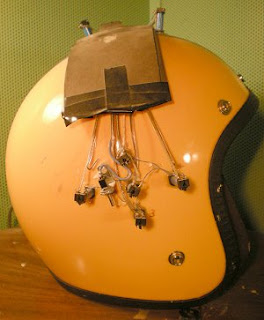God Helmet
 |
| The "God Helmet" refers to an experimental apparatus originally called the "Koren helmet" after its inventor Stanley Koren |
Mechanical Induction-
Magnetic stimulation of the brain, as with the God helmet developed by Michael Persinger.[30]
Dr. Persinger's work is primarily published in peer-reviewed
academic journals devoted to neuroscience and cognitive studies.
Persinger does not reject the validity of spiritual and psychic
experiences. His many papers and experiments offer specific mechanisms
for how the brain can create them subjectively. Proof that God is in
the brain means that the power of prayer lies in the human mind.
Meditation works by making changes in the brain. The kingdom of heaven
lies within the complexities of the brain, the most complex object
known to science. This field of inquiry has been called neurotheology
by several authors and journalists, though it's members usually have
other names for themselves.
Transcranial magnetic stimulation
_is_a_technique_for_noninvasive_stimulation_of_the_adult_brain.jpg) |
| Repetitive transcranial magnetic stimulation
(rTMS) is a technique for noninvasive stimulation of the adult brain.
Stimulation is produced by generating a brief, high-intensity magnetic
field by passing a brief electric current through a magnetic coil.
Compared with the growing number of clinical trial with rTMS, there are
surprisingly few animal studies on its basic mechanisms of action,
constraining the ability to perform hypothesis-driven clinical studies. |
Okay one knows that we live in a material world so one has to
apply scientific view to what can be induced toward consciousness, has a different
perspective value here on the assumption about "what matters and what
arises as consciousness from it?"
Is there then not room to look at the effect on the brain matter as the
value of how consciousness may be perceived "as outside the body?"
Quote:
Assisted
by specialists in psychology, medicine, biochemistry, psychiatry,
electrical engineering, physics, and education, Robert Monroe developed
Hemi-Sync, a patented audio technology that is claimed to facilitate enhanced performance.[2][3][4][5][6]
Using this point then of observation about what in going on in the
brain. Why do we not consider the effect of stimulation in terms of the
brain, as having other methods already established that affect
consciousness indicated above. Affecting various stages of consciousness as gradations as to imply
"focus levels" that we are engaged in. In this regard, correlated to
our daily lives.
To be able to stimulate the brain so as to consider consciousness
interaction with nature on various levels. This would ask how far
consciousness may travel in that we do not consider this focus as
travelling further from the confines of the body then just above it as
measured by the stimulation?
So one might be affected by the innovation of idea as a manifested
and work in progress to say this invention does not really deal with
reality? Consciousness is such a fickle thing that no one truly has the
method in the bag?
Brain Mechanisms of Consciousness
Quote:
Consciousness
is at once the most familiar and the most mysterious feature of our
existence. A new science of consciousness is now revealing its
biological basis.
Once considered beyond the reach of
science, the neural mechanisms of human consciousness are now being
unravelled at a startling pace by neuroscientists and their colleagues.
I've always been fascinated by the possibility of understanding
consciousness, so it is tremendously exciting to witness – and take
part in – this grand challenge for 21st century science. SEE:Consciousness: Eight questions science must answer
See:









_is_a_technique_for_noninvasive_stimulation_of_the_adult_brain.jpg)

















